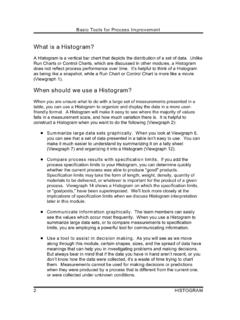Transcription of FLOWCHART - Saferpak
1 Basic Tools for Process Im provem ent FLOWCHART . FLOWCHART 1. Basic Tools for Process Im provem ent What is a FLOWCHART ? A FLOWCHART is a diagram that uses graphic symbols to depict the nature and flow of the steps in a process (Viewgraph 1). Another name for this tool is "flow diagram.". When should teams use Flowcharts? At the beginning of your process improvement efforts, an as-is FLOWCHART helps your team and others involved in the process to understand how it currently works. The team may find it helpful to compare this as-is FLOWCHART with a diagram of the way the process is supposed to work. Later, the team will develop a FLOWCHART of the modified process again, to record how it actually functions. At some point, your team may want to create an ideal FLOWCHART to show how you would ultimately like the process to be performed.
2 Among the benefits of using Flowcharts (Viewgraph 2). are that they ! Prom ote understanding of a process by explaining the steps pictorially. People may have differing ideas about how a process works. A FLOWCHART can help you gain agreement about the sequence of steps. Flowcharts promote understanding in a way that written procedures cannot do. One good FLOWCHART can replace pages of words. ! Provide a tool for training em ployees. Because of the way they visually lay out the sequence of process steps, Flowcharts can be very helpful in training employees to perform the process according to standardized procedures. ! Identify problem areas and opportunities for process im provem ent. Once you break down the process steps and diagram them, problem areas become more visible.
3 It is easy to spot opportunities for simplifying and refining your process by analyzing decision points, redundant steps, and rework loops. ! Depict custom er-supplier relationships, helping the process workers to understand who their customers are, and how they may sometimes act as suppliers and sometimes as customers in relation to other people. Some practical applications for flowcharting are: The steps in troubleshooting a broken turbine The process used to fight a class BRAVO fire How to clean a berthing compartment The process used for getting the ship underway 2 FLOWCHART . Basic Tools for Process Im provem ent What Is a FLOWCHART ? A diagram that uses graphic symbols to depict the nature and flow of the steps in a process.
4 FLOWCHART VIEWGRAPH 1. Benefits of Using Flowcharts Promote process understanding Provide tool for training Identify problem areas and improvement opportunities Depict customer-supplier relationships FLOWCHART VIEWGRAPH 2. FLOWCHART 3. Basic Tools for Process Im provem ent What symbols are used in Flowcharts? The sym bols that are commonly used in Flowcharts (Viewgraph 3) have specific m eanings and are connected by arrows indicating the flow from one step to another: Oval. Ovals indicate both the starting point and the ending point of the process steps. Box. A box represents an individual step or activity in the process. Diam ond. A diamond shows a decision point, such as yes/no or go/no-go. Each path emerging from the diamond must be labeled with one of the possible answers.
5 Circle. A circle indicates that a particular step is connected to another page or part of the FLOWCHART . A letter placed in the circle clarifies the continuation. Triangle. A triangle shows where an in-process measurement occurs. What are the levels of FLOWCHART detail? When you are developing a FLOWCHART , consider how it will be used and the amount and kind of information needed by the people who will use it. This will help you determine the level of detail to include. Viewgraph 4 compares the levels described below using the process for producing the Plan of the Day (POD). Macro level. The top leadership may not need the amount of detail required by the workers in a process. A "big picture," or macro-level, view of the process may be enough for their purposes.
6 Generally, a macro-level FLOWCHART has fewer than six steps. Think of it as a view of the ground from an airplane flying at 30,000 feet. Mini level. The term "mini" or "midi" is used for a FLOWCHART that falls between the big picture of the macro level and the fine detail of the micro level. Typically, it focuses on only a part of the macro-level FLOWCHART . Using the airplane analogy, you see the level of detail as if looking at the ground from 10,000 feet. Micro level. People trying to improve the way a job is done need a detailed depiction of process steps. The micro-level, or ground-level, view provides a very detailed picture of a specific portion of the process by documenting every action and decision. It is commonly used to chart how a particular task is performed.
7 4 FLOWCHART . Basic Tools for Process Im provem ent Symbols Used in Flowcharts Start / End Process Step No Decision Yes Connector Measurement M. FLOWCHART VIEWGRAPH 3. Levels of Flowcharts MACRO MINI MICRO. Turn on Start Start computer Start word proc. applic. Draft Get rough POD draft of POD. Is rough in No Type word proc. rough POD. Type applic. POD Is it No Get ? approved approval Yes ? Edit POD. Distribute POD Yes Are Type there any Yes Make smooth corrections corrections End ? No End Print POD. FLOWCHART VIEWGRAPH 4. FLOWCHART 5. Basic Tools for Process Im provem ent The label used is not important. What matters is that the people constructing a FLOWCHART understand how the information is going to be used and the people interpreting the chart understand the level of detail it presents.
8 How do we get started? Many methods for constructing Flowcharts have been described and you can safely use any one of them, as long as you start out by doing these things: ! Identify the right people to develop the chart. ! Determine what you expect to get from the FLOWCHART . ! Identify who will use it and how. ! Define the level of detail you need. ! Establish the boundaries of the process to be improved. A word about boundaries. These are the starting and ending points for your FLOWCHART . For example, process boundaries for a repair shop overhauling a pump might be when the pump enters the shop and when it passes final testing. The boundaries determine the number of activities to be studied and the number of people involved in the process, functionally and cross-functionally.
9 At first, many teams struggle with the FLOWCHART tool. Team members may be unsure about process boundaries or disagree on the level of detail needed. The first few drawings quickly become a tangled mess of lines as steps are added, moved, and reconnected. And most discouraging of all, workers may question the value of the FLOWCHART and fail to use it in their daily work. What are the keys to successful flowcharting? Many of these difficulties can be avoided or overcome by applying the keys to success outlined in Viewgraph 5. It is vital that you start by depicting the process the way it really works, not the way you think it should work. You need to chart the process as it is. Later you can chart it as it is supposed to work (by regulation), or as you would like it to work (your ideal picture of the process).
10 Here are the keys: ! Start with the big picture. It is best to draw a macro-level FLOWCHART first. After you've depicted this big picture of the process, you can develop other diagrams with increased levels of detail. ! Observe the current process. A good way to start Flowcharting a process is to walk through the current process, observing it in actual operation. 6 FLOWCHART . Basic Tools for Process Im provem ent Keys to Success Start with the big picture Observe the current process Record process steps Arrange the sequence of steps Draw the FLOWCHART FLOWCHART VIEWGRAPH 5. FLOWCHART 7. Basic Tools for Process Im provem ent ! Record the process steps you observed. Record the steps as they actually occur in the process as it is.









